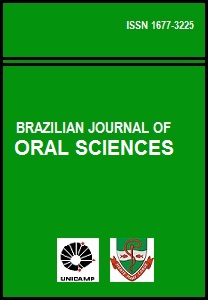Abstract
Aim: To assess inter-examiner reproducibility in the detection of 20 occlusal caries in permanent teeth using three diagnostic codes and criteria: WHO (1997), Nyvad and ICDAS-II. Methods: Three graduate students (G) and two undergraduate dental students (UG) without previous experience in the use of Nyvad and ICDAS-II were trained by a reference examiner. Examiner validity was assessed by consensus agreement between the investigators. Two cutoff points were used for ICDAS-II and Nyvad to represent reproducibility values: the A- lesion, B- cavity lesion. Results: According to the examiners consensus, the kappa values ranged from 0.71 to 0.85 for G group and from 0.85 to 0.95 for UG group (ICDAS-II). For the Nyvad index values varied from of 0.77 to 1.00 (G) and from 0.65 to 0.74 (UG), for the WHO index, values obtained ranged from 0.66 to 1.00 (UG) and 1.00 (G). Using a cutoff A, interexaminers reproducibility (ICDAS-II) ranged from 0.73 to 0.87 (G) and 1.00 (UG). According to Nyvad criteria, the kappa value ranged from 0.78 to 1.00 (G) and from 0.70 and 0.90 (UG) when compared to the consensus. The kappa values using the cutoff point B ranged from 0.66 to 1.00 (G), 0.76-0.89 (UG) in ICDAS-II and the in Nyvad criteria varied from 0.87 to 1.00 (G) and from 0.65 to 0.88 (UG). Conclusions: Reproducibility values ranged from good to perfect. The reproducibility revealed precise answers in the occlusal caries lesions diagnosis according to the criteria used. The best use of reliability tools for examiner training was important regardless of the examiners being undergraduate or graduate students.The Brazilian Journal of Oral Sciences uses the Creative Commons license (CC), thus preserving the integrity of the articles in an open access environment.
Downloads
Download data is not yet available.

